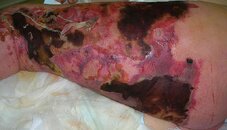vjongene
Contributor
Last summer I was in Micronesia on the Thorfinn for a two-week cruise in the rather isolated waters between Yap and Chuuk atolls. About one week into the cruise, the Captain developed a rather nasty-looking infection on his leg, after having suffered a minor scratch while working on the ship's power plant. After it started visibly swelling and turning red and purple, he treated it with antibiotics (I do not know which ones) and brought it more or less under control. He still had to go to a local clinic on Chuuk to have a doctor look at it.
Towards the end of the same trip, my dive buddy and I both developed similar symptoms, starting from an insect bite or minor scratch. We treated them with topical antibiotics (typical OTC cream), with limited success. My infected leg started hurting quite badly one evening on shore, and one my diving friends gave me a full dose of Augmentin (amoxicillin + clavulanate), which I started taking according to recommended dosage for a full 5-day treatment. The swelling and pain subsided rapidly (by the next day). My buddy flew off the next day, and I learned later that his infection had flared up pretty badly during his flight back to Switzerland. He ended up being hospitalized for several days and treated with massive doses of antibiotics. His infection was diagnosed as erysipelas, with a Streptococcus as the infectious agent. Another guest on board developed a similar problem a couple of days later, and he suffered excruciating pain with no possibility of treatment (no one knew what to do with him during a stopover in Guam) durng his flight home. He also ended up in the hospital.
For me, there was an epilogue in that I developed an allergy to amoxicillin and had a pretty bad rash for a few days.
The question is, is this a relatively common occurrence on dive boats? Having guests and crew confined in a relatively small space for extended periods of time cannot help. And the sharing of e.g. towels, kitchenware etc could also be a factor. Any other experiences and/or medical advice would be welcome.
Victor
Towards the end of the same trip, my dive buddy and I both developed similar symptoms, starting from an insect bite or minor scratch. We treated them with topical antibiotics (typical OTC cream), with limited success. My infected leg started hurting quite badly one evening on shore, and one my diving friends gave me a full dose of Augmentin (amoxicillin + clavulanate), which I started taking according to recommended dosage for a full 5-day treatment. The swelling and pain subsided rapidly (by the next day). My buddy flew off the next day, and I learned later that his infection had flared up pretty badly during his flight back to Switzerland. He ended up being hospitalized for several days and treated with massive doses of antibiotics. His infection was diagnosed as erysipelas, with a Streptococcus as the infectious agent. Another guest on board developed a similar problem a couple of days later, and he suffered excruciating pain with no possibility of treatment (no one knew what to do with him during a stopover in Guam) durng his flight home. He also ended up in the hospital.
For me, there was an epilogue in that I developed an allergy to amoxicillin and had a pretty bad rash for a few days.
The question is, is this a relatively common occurrence on dive boats? Having guests and crew confined in a relatively small space for extended periods of time cannot help. And the sharing of e.g. towels, kitchenware etc could also be a factor. Any other experiences and/or medical advice would be welcome.
Victor




